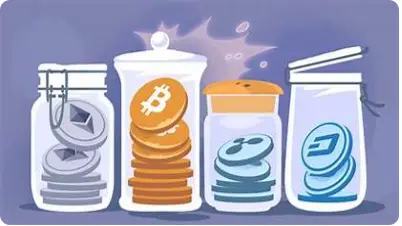Store and Grow
How to Store Cryptocurrency: Protecting Your Digital Assets
Cryptocurrency is becoming increasingly popular, but one fundamental question remains: how can you store it safely? New users often face the challenge of choosing between hot wallets, cold wallets, hardware devices, and exchanges. Secure cryptocurrency storage is not only about convenience, but primarily about protecting your assets from hackers, fraud, and technical failures. Knowing how to store cryptocurrency is just as important, if not more important, than knowing how to earn it.

Making the wrong storage choice can cost you all your funds. In this guide, we will review the main storage methods, explain how to choose the best option based on your usage frequency, and help you avoid common crypto storage mistakes. The security of your digital assets depends on a thoughtful approach and strict adherence to private key management rules.
Hot vs. Cold Wallets: Choosing the Right Crypto Storage Method
The first step after acquiring crypto on a major exchange (like Binance or Coinbase) or a DEX (like Uniswap or PancakeSwap) is transferring it off-exchange. The primary decision is between internet-connected and offline storage solutions.
Hot Wallets: Convenience for Active Traders
Hot wallets (or software wallets), such as MetaMask or Trust Wallet, are convenient for daily transactions and small amounts. They are always connected to the internet, offering instant access to DeFi platforms and NFT marketplaces. However, their online nature makes them vulnerable to phishing attacks and malware. They are suitable for active users but require enhanced security protocols and are not recommended for large, long-term holdings.

Main Hot Wallet Methods:
- Browser Extensions: Ideal for Web3 access (e.g., MetaMask).
- Mobile Wallets: Convenient for everyday payments (e.g., Trust Wallet).
Cold Wallets: Maximum Security and Long-Term Holding
Cold wallets (or hardware wallets) are offline devices (like Ledger or Trezor) that keep your private keys physically isolated from the internet. They are the most secure option for storing larger amounts and are optimal for long-term crypto storage and protection from online theft. While they offer superior protection, they require careful management of the physical device and the seed phrase (recovery phrase).
While often mentioned as an extreme form of cold storage, paper wallets—physical printouts of keys—are generally considered legacy and come with significant risks of physical damage, ink degradation, or simple loss. The modern best practice for cryptocurrency security is the hardware wallet, combined with meticulous offline storage of the recovery phrase. This seed phrase (typically 12 or 24 words) is the master key to your funds. Crucially, the phrase should never be digitized (no photos, no cloud storage) to fully mitigate remote hacking threats, making the protection of the physical seed a non-negotiable security step.
Ledger vs. Trezor: Hardware Wallet Comparison
| Feature | Ledger (e.g., Nano S/X) | Trezor (e.g., Model T) |
|---|---|---|
| Security Element | Proprietary Secure Chip (CC EAL5+) | Open-source design |
| Interface | Uses Ledger Live desktop/mobile app | Uses Trezor Suite desktop app |
| Coin Support | Broad, managed via Ledger Live | Broad, slightly fewer native apps |
| Screen Type (Top Models) | Small physical screen | Larger touch screen |
| Key Focus | Maximum certified security | Full transparency (Open Source) |
Key Cold Storage Recommendations:
- Do not keep large amounts on exchanges — they are custodians and can be hacked.
- Use hardware wallets — they provide the highest security standard for hodling.
- Diversify assets — splitting funds across multiple hardware wallets reduces catastrophic risk.
Essential Security Measures: 2FA, Private Keys, and Backups
Protecting crypto assets requires a comprehensive, layered security approach. Major threats include phishing, SIM-swap attacks, and data theft. A robust digital asset protection strategy minimizes risks and safeguards your funds from common vulnerabilities.

Private Key and Seed Phrase Management
The private key is the ultimate proof of ownership. Never share your private keys or seed phrase with anyone, and never input them on any website or app. This phrase must be stored offline (physically written down) in a secure, fireproof location. Always enable two-factor authentication (2FA) using a dedicated app (like Authy or Google Authenticator) on all crypto-related services and accounts (especially on major exchanges like trusted cryptocurrency exchanges). Avoid SMS-based 2FA as it is vulnerable to SIM-swapping.
For large treasury holdings or organizational funds, multisignature (multisig) wallets provide an advanced security layer. These wallets require signatures from a pre-defined number of key holders (e.g., 3 out of 5) to authorize a transaction, eliminating single points of failure. Furthermore, serious investors must address crypto inheritance planning. Without clear instructions and secure key access for beneficiaries, assets can be permanently lost. Documenting your asset distribution and private key locations is a crucial, often overlooked, aspect of responsible digital wealth management.
Tips to Minimize Hacking Risks:
- Enable 2FA on all accounts and wallets.
- Use complex, unique passwords and avoid storing them in browsers or cloud services.
- Always verify website addresses before entering any credentials (to avoid phishing).
- Consider multisignature wallets for joint accounts or enhanced protection on important transactions, as they require multiple keys to authorize.
Crypto Portfolio Management: Stablecoins, DeFi, and Long-Term Strategy
Storing capital in crypto requires a smart strategy beyond just the wallet type. The goal is to not only secure the funds but also preserve or grow their value.
How to Preserve and Grow Capital
The best approach to protecting against market volatility is holding a portion of your capital in stablecoins (such as USDT or USDC), which are pegged to the US dollar. Furthermore, smart investors separate assets into short-term (active trading) and long-term investments (cold storage). For growth, passively investing in DeFi yield farming on platforms with audited smart contracts can increase returns, but requires understanding the associated risks.

Key Strategies for Safe Holding:
- Long-term storage should be exclusively in hardware or offline wallets.
- Diversify assets across multiple coins (not just Bitcoin) and multiple wallets.
- Monitor incoming transactions and avoid clicking links from unknown senders (phishing avoidance).
- Regularly update wallet software and firmware to patch vulnerabilities.
Conclusion: Reliable Storage for Your Digital Future
Effective crypto management involves continuous security monitoring. Keep large funds in multiple offline wallets, store private keys securely, and use robust 2FA for account protection. Stay alert to new threats, especially phishing and social engineering. The fundamental rule for crypto for beginners is simple: You are your own bank.
P.S. When investing in cryptocurrency, it is important not only to follow the market price but also to understand storage mechanisms. Use only verified wallets, avoid suspicious apps, and never share your private keys with anyone. The security of your assets is entirely your responsibility.
Disclaimer / No Liability
We are not financial advisors and assume no responsibility for any decisions you make.
Cryptocurrencies are highly volatile and risky. You may lose all invested capital.
Always do your own research (DYOR) and consult qualified professionals before making any financial or legal decisions.
We make no guarantees regarding the accuracy, completeness, or reliability of the information provided.
References to third-party services or projects do not imply endorsement.
By using this site, you agree that all actions are at your own risk and you release the site owners and authors from any liability.
